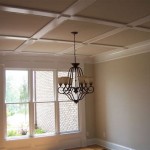Why Do Old English Houses Have Low Ceilings?
The prevalence of low ceilings in older English houses is a characteristic feature that often puzzles modern homeowners. While contemporary building practices prioritize high ceilings to create a sense of spaciousness and grandeur, historical English homes frequently feature ceilings that appear relatively low and cramped. The reasons for this design choice are multifaceted, encompassing practical considerations, economic factors, and the technological limitations of the time. Understanding these factors provides valuable insight into the lives and priorities of those who built and inhabited these historic dwellings.
It is important to distinguish between different historical periods when examining this architectural trend. While very early structures might have low ceilings due to purely rudimentary construction techniques, later periods, spanning from the medieval era through the Victorian age, saw a more deliberate application of low ceilings, influenced by a complex interplay of functional needs and societal norms. Examining these periods individually reveals the specific drivers behind this consistent design feature.
Energy Efficiency and Heat Conservation
One of the most significant contributors to low ceilings in old English houses is the need for energy efficiency and heat conservation. Prior to the advent of modern heating systems, dwellings relied primarily on fireplaces for warmth. Heat rises, and in a room with high ceilings, a substantial amount of heat would accumulate near the ceiling, leaving the occupants at ground level feeling cold. Lowering the ceiling significantly reduced the volume of air to be heated, allowing the warmth from the fireplace to circulate more effectively and maintain a comfortable temperature throughout the living space.
The impact of this design strategy was particularly pronounced during the colder months. England's climate, characterized by long, damp winters, made efficient heating a crucial consideration for survival. Reducing the cubic footage of a room minimized heat loss through the roof and walls. In addition to heat conservation, smaller rooms also allowed for quicker warming. This was especially beneficial for people working on crafts inside the home as the warmth allowed their fingers to be more nimble in cold weather.
Furthermore, the materials used in construction played a role. Traditional building materials, such as stone, timber, and wattle and daub, offered limited insulation compared to modern materials. This lack of insulation exacerbated heat loss, making it even more critical to minimize the volume of space requiring heating. The lower ceiling height effectively compensated for the poor insulation, creating a more energy-efficient environment. This was particularly important for poorer families who could not afford to waste precious fuel sources like wood or coal.
Construction Techniques and Material Limitations
The construction techniques and available materials significantly influenced ceiling heights in older English houses. Traditional building methods often involved the use of relatively short timbers, which naturally limited the span and height of ceilings. Obtaining long, straight timbers was a challenging and expensive undertaking, particularly prior to the widespread adoption of sawmills. Consequently, builders tended to work with smaller, more readily available materials, resulting in lower ceiling heights.
The structural integrity of a building was also a major concern. Supporting a high ceiling over a large span required more complex and expensive structural supports. Lower ceilings, on the other hand, simplified the construction process, requiring fewer supporting beams and less skilled labor. This was particularly relevant in rural areas, where access to skilled craftsmen and expensive materials was often limited. Furthermore, houses were often built incrementally, adding rooms as finances allowed, and sticking to established building methods ensured structural stability with simpler designs.
Moreover, the type of roofing material used also affected ceiling height. Heavy roofing materials, such as slate or clay tiles, placed significant stress on the supporting walls and roof structure. Lower ceilings helped to distribute this weight more evenly, reducing the risk of structural failure. This was especially important in areas prone to earthquakes or strong winds. The limitations imposed by available materials and construction techniques, therefore, played a crucial role in shaping the characteristic low ceilings of old English houses.
Economic and Social Factors
Economic and social factors also contributed to the prevalence of low ceilings in historical English homes. Building materials were often expensive, and labor costs could be substantial. Lowering the ceiling height reduced the amount of materials required, thereby lowering the overall cost of construction. This was particularly appealing to families with limited financial resources, allowing them to afford a dwelling that would otherwise be beyond their means.
Social hierarchies also played a role. While grander estates and manor houses often featured higher ceilings as a display of wealth and status, smaller homes, occupied by the working class and middle class, prioritized practicality and affordability over ostentatious displays. Lower ceilings reflected the economic realities of the majority of the population, focusing on functional living spaces rather than symbolic grandeur. It's important to note that even within these social classes, the ceilings wouldn't be unnecessarily low, and often were still high enough to accommodate activities without excessive crouching.
Furthermore, the function of the rooms within the house influenced ceiling height. In rooms primarily used for sleeping or storage, lower ceilings were considered acceptable and even desirable for warmth and security. Living rooms and kitchens, where people spent more time engaged in activities, might have slightly higher ceilings, but even these spaces typically lacked the soaring heights commonly found in modern homes. The prioritization of functionality over aesthetics, driven by economic and social constraints, significantly shaped the design of old English houses.
The Influence of Taxation and Regulations
Historical tax policies in England also played a role in influencing the size and shape of houses, indirectly affecting ceiling heights. Window taxes, for example, were levied based on the number of windows in a property. To minimize their tax burden, homeowners often built smaller houses with fewer windows, which in turn meant smaller rooms with lower ceilings. Avoiding excessive taxation was a significant concern for many homeowners, and architectural designs were often tailored to minimize these costs.
Building regulations, although less formal than modern building codes, also influenced the construction of houses. While specific regulations regarding ceiling heights were not always explicitly stated, prevailing building practices and customary standards tended to favor lower ceilings due to the factors discussed earlier, such as structural stability and heat conservation. Builders generally adhered to established norms, and deviations from these norms were often viewed with suspicion or disapproval.
Moreover, the availability and cost of land also played a role. In densely populated areas, land was a valuable commodity, and homeowners sought to maximize the use of available space. Building upwards was often more expensive and challenging than building outwards, leading to a preference for single-story or two-story houses with relatively low ceilings. The combined effect of taxation, regulations, and land costs further reinforced the trend towards lower ceilings in old English houses.
In conclusion, the characteristic low ceilings of old English houses are not simply a matter of chance or aesthetic preference. They are the result of a complex interplay of practical considerations, economic realities, and technological limitations. Energy efficiency, construction techniques, economic factors, and even taxation policies all contributed to this distinctive architectural feature. Understanding these factors provides a valuable glimpse into the lives and priorities of those who built and inhabited these historic dwellings.

Low Ceilings Old Home No Problem On The Drawing Board

The Househunter Low Ceilings And Awkward Shapes Mad About House

Low Ceilings Old Home No Problem On The Drawing Board

The Househunter Low Ceilings And Awkward Shapes Mad About House

Raising The Bar On Lower Ceilings Patrick Ahearn Architect

Low Ceilings Old Home No Problem On The Drawing Board

The Househunter Low Ceilings And Awkward Shapes Mad About House

The Househunter Low Ceilings And Awkward Shapes Mad About House
Are There Any Disadvantages To Having Low Ceilings In A House Quora
Why Are Doorways In England So Low Quora
Related Posts








